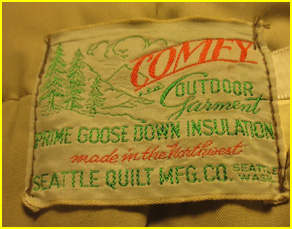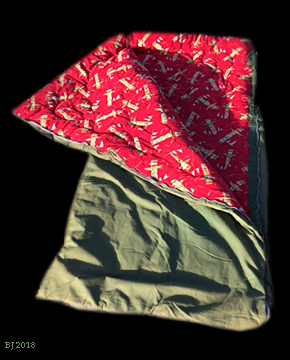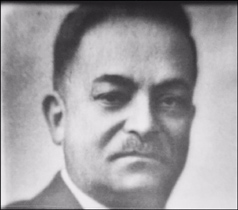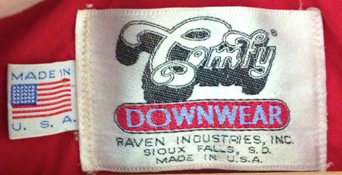

 Claims
to Fame within The History of Gear-- Seattle Quilt was perhaps
the first company to create a true down sleeping bag. This was
in about 1920. The bags were nothing like modern, lightweight,
nylon-shelled down bags; instead, they were essentially quilts
filled with down, given Army duck covers and equipped with harness
snaps around the perimeter to snap them into a sleeping-bag like
configuration! It's also noteworthy that Seattle Quilt experimented
with various baffling systems before and during World War II,
including overlapping tube and box-type baffling.
Claims
to Fame within The History of Gear-- Seattle Quilt was perhaps
the first company to create a true down sleeping bag. This was
in about 1920. The bags were nothing like modern, lightweight,
nylon-shelled down bags; instead, they were essentially quilts
filled with down, given Army duck covers and equipped with harness
snaps around the perimeter to snap them into a sleeping-bag like
configuration! It's also noteworthy that Seattle Quilt experimented
with various baffling systems before and during World War II,
including overlapping tube and box-type baffling.
"Comfy" -- this was a brand name officially registered for use by Seattle Quilt in 1936, about 20 years after the founding of Seattle Quilt. The "Comfy" name, however, was in use as early as the 1880s in Latvia, before the founding family moved to America. This venerable name was allowed to expire by its then-owner Raven Industries in 1996.
The 1959 video snippet below shows workers filling a down quilt in the "down room" at the Seattle Quilt factory. The women are using what amounts to a vacuum cleaner running in reverse, which was the same technique Holubar Mountaineering was using in Colorado in the same timeline; it's unclear who invented this technique first.... The snippet is taken from a 30 minute movie, called 'Success Story' that was aired on King TV (ch 5) in Seattle on 1 Sept 1959... This video will display under Quicktime. It may run automatically, or you may have to click on it. Check to see if you have Apple Quicktime on your computer (it's a free download from Apple if you don't). The video runs fine on my Desktop PC running Windows 7, and also runs fine on my Apple iPhone6. Let me know if you have trouble viewing this video: oldgear@oregonphotos.com (Contact Me)
Story Source: my main source has been Charles Hammer,
whose father was Leonard Hammer, the factory's Production
Manager for many years after WW II and into the 50s and 60s until
he (Leonard) retired from the company. (picture: Leonard being interviewed by KING TV in 1959,
Leonard on right).... Mr. Hammer related, " Leonard's Mother
was Uncle Charlie's sister. Thus my Dad did not marry into the
company but was born into it being Uncle Charlie's nephew."
Therefore, Seattle Quilt's owner, Morris Miller, was Mr.
Hammer's Uncle and fondly known to Mr. Hammer as "Uncle Morrie."
Mr. Hammer as a boy spent much time in the factory and was very
familiar with most aspects of the business: "From the cutting
room to the down filling rooms, from the repair shop for the machinery
to actually sewing, there was very little about the factory I
did not know."
(picture: Leonard being interviewed by KING TV in 1959,
Leonard on right).... Mr. Hammer related, " Leonard's Mother
was Uncle Charlie's sister. Thus my Dad did not marry into the
company but was born into it being Uncle Charlie's nephew."
Therefore, Seattle Quilt's owner, Morris Miller, was Mr.
Hammer's Uncle and fondly known to Mr. Hammer as "Uncle Morrie."
Mr. Hammer as a boy spent much time in the factory and was very
familiar with most aspects of the business: "From the cutting
room to the down filling rooms, from the repair shop for the machinery
to actually sewing, there was very little about the factory I
did not know."
Charles Hammer (not the
Charles who founded the company in 1915) wrote, "For the timeline
you really have to start in Riga, Latvia in the late 1880's. There
my Great Grandmother, Esther Milwitzky, was making quilts out
of her home. According to family lore she was using the name of
'COMFY' to label her wares. About 1895 Esther, along with her
husband Issac, sons Jacob, Charles and the rest of a rather large
family moved to America to live in Philadelphia. Sometime in 1897
they all became American citizens. By 1915 Jacob and Charles,
now called Jack and Charlie, 'Americanized' their family names
to Miller and moved to Seattle
via a stop working on the Panama Canal. Picture: Founder
Charles Miller (Milwitzky)....  Charlie
and Jack immediately started making quilts like their mother had
taught them to make earlier in their life. They called their company
Seattle Quilt Mfg Co. They were then working out of a small garage
on 21st Ave near Cherry Street. They used the trade name of COMFY
to honor their Mother. These quilts were mostly made of cotton
and wool with a few, for the more affluent customers, out of down.
Soon they moved to 1026 1st Ave S. Most of the down used was either
from Europe or America with some also coming from a small Mennonite
community out of Calgary. At this time down was usually gotten
from plucking the birds seasonally. The birds were mostly raised
for the eggs and down and thus were kept alive.... By 1917 growth
had forced them to move again, this time to 524 1st Ave S. They
had then about 20 sewing machines, mostly making quilts to be
sold to local Seattle retail outlets. These quilts were constructed
of the sewn-through style. Sometime around 1920 the Alaskan Railroad
between Seward and Fairbanks started being built and Seattle Quilt
was contracted to make bedding for the workers. Quilts were given
canvas covers and then at first harness snaps followed by snap
buttons down the sides and across the bottoms to create what we
now call sleeping bags. Very long zippers at that time were extremely
expensive and thus not used. Also during this period an overlapping
tube style of construction was originated to help insulate without
having the warmth being lost through the seams. From now on through
WW2 was a boom time for the sleeping bag industry. Seattle Quilt
even got a large order from the Quartermaster Corps of the U.
S. Army at Fort Mason, California, 6 months prior to Pearl Harbor.
Those guys in California must have known something was in the
works! By the end of WW2 most of the bags being produced had the
box style of construction, probably as it was a more efficient
way to sew them up."
Charlie
and Jack immediately started making quilts like their mother had
taught them to make earlier in their life. They called their company
Seattle Quilt Mfg Co. They were then working out of a small garage
on 21st Ave near Cherry Street. They used the trade name of COMFY
to honor their Mother. These quilts were mostly made of cotton
and wool with a few, for the more affluent customers, out of down.
Soon they moved to 1026 1st Ave S. Most of the down used was either
from Europe or America with some also coming from a small Mennonite
community out of Calgary. At this time down was usually gotten
from plucking the birds seasonally. The birds were mostly raised
for the eggs and down and thus were kept alive.... By 1917 growth
had forced them to move again, this time to 524 1st Ave S. They
had then about 20 sewing machines, mostly making quilts to be
sold to local Seattle retail outlets. These quilts were constructed
of the sewn-through style. Sometime around 1920 the Alaskan Railroad
between Seward and Fairbanks started being built and Seattle Quilt
was contracted to make bedding for the workers. Quilts were given
canvas covers and then at first harness snaps followed by snap
buttons down the sides and across the bottoms to create what we
now call sleeping bags. Very long zippers at that time were extremely
expensive and thus not used. Also during this period an overlapping
tube style of construction was originated to help insulate without
having the warmth being lost through the seams. From now on through
WW2 was a boom time for the sleeping bag industry. Seattle Quilt
even got a large order from the Quartermaster Corps of the U.
S. Army at Fort Mason, California, 6 months prior to Pearl Harbor.
Those guys in California must have known something was in the
works! By the end of WW2 most of the bags being produced had the
box style of construction, probably as it was a more efficient
way to sew them up."
By 1959, the booming company occupied a 7,000 sz. ft. facility and employed over 100 people in "production," according to Leonard Hammer, with a total workforce of 150-175. Charles Hammer told me that in this era and into the 60s, Seattle was a thriving sewing center for outdoor gear, including such big names as Eddie Bauer, Tempco, Black Manufacturing, Washington Quilt, Roffe (ski wear), Lasley Knits, and Sportcaster. Even Portland, Oregon's big name "Alaska Sleeping Bag Co." "bought enough from Seattle Quilt that we put their own labels on the stuff [we made] for them and drop-shipped much of their orders from our warehouse on 1st. Ave."
In 1971, Morris Miller (of the founding family of Seattle Quilt Mfg Co) sold to a corporation, the Olin Corporation. In a later event, Olin sold the brand to Raven Industries of Sioux Falls, South Dakota. Raven allowed the Comfy name to go extinct in 1996. Down garments with "Comfy" labels probably stopped being manufactured several years prior to 1996, but I have no firm date.... I solicit reader input to tack down a more exact date of when production stopped. Contact me at: brucej@oregonphotos.com

BOOK ALERTS: I have written five books about prominent companies in the History of Outdoor Gear. My first was about Frostline Kits of Colorado. Please visit my FROSTLINE PAGE (click here) for a link to order it, or to view a free 15 page PDF preview. The second book is titled, "GERRY, To Live in the Mountains" (click here). The third book describes the story of HolubarMountaineering Ltd. My fourth book is "MSR, Defying Tradition and is about the early days of Mountain Safety Research (MSR)... My fifth book is about Stephenson's Warmlite Equipment Co.. Later this year, I will pull together several related Seattle-area gear companies into one book, among them Seattle Quilt/Comfy. This next book is probably going to be an e-Book in Kindle format.
Please Note: All Material above, and in all my "History of Gear" webpages, is copyrighted, and no usage of my material is permitted unless explicit permission is granted by me, Bruce B. Johnson, owner of OregonPhotos.com. ... Editors: Please contact me at brucej@Oregonphotos.com if you have interest in publishing....Others: if you were involved with one of the old-line, vintage gear companies and have a story to tell in these pages, please contact me soon.
